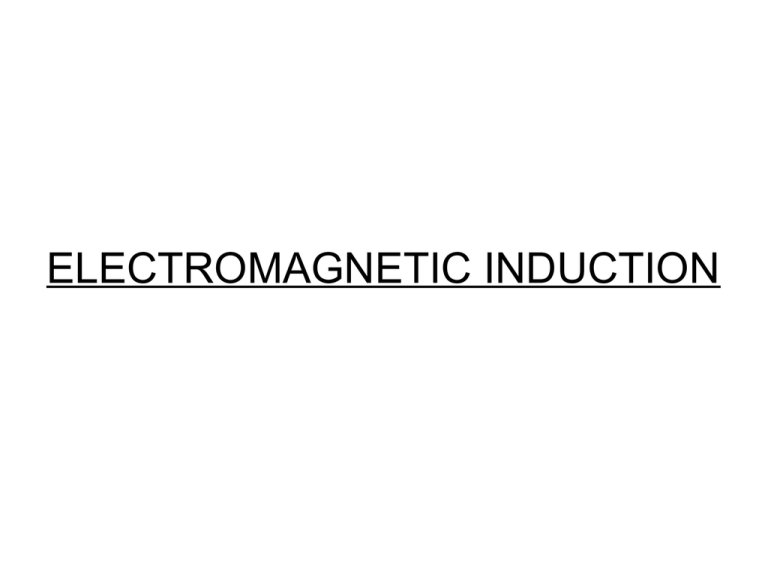ELECTROMAGNETIC INDUCTION
advertisement

ELECTROMAGNETIC INDUCTION Electromagnetic Induction ● Magnetic fields resist changes to their state – ● Similar to a large mass resisting changes in velocity When a change is made to a B field – – A new B field is “induced” → direction opposes change Any moving magnet feels a resisting force S N vmagnet ● Bmagnet Binduced P Bmagnet is getting stronger at point P Therefore Binduced opposes Bmagnet This process is called electromagnetic induction – The resisting nature of the force is called “Lenz's Law” Induced Current ● Does Binduced have an electric current source? – Experiment: A moving magnet near a conducting metal Binduced is stronger due to induced current in the metal – Conclusion: Changing B field → electric current → Binduced – ● Can now produce current without a battery! This is called “alternating current” (AC) because the current switches direction... Batteries produce direct current (DC), which moves in a constant direction Eddy Currents ● Current can be induced in any conducting material – ● Induced currents resemble “whirlpools” – ● Not just iron, and not just wire loops! And are called “eddy” currents Metal detectors – – Move an electromagnet past a metal And detect the eddy currents Magnetic Flux ● To calculate the induced current in a wire loop: – – ● Must measure the changing B field around the whole loop Mathematically, there is a simpler way: B Magnetic Flux (ϕB) – Measure of how B field penetrates a loop B = B ⊥ A = B A cos – Unit: 1 Weber (W) = 1 T m 2 B ϕ Faraday's Law ● General rule covering electromagnetic induction ● Changing magnetic flux produces an EMF – – Which can produce a current (if a conductor is nearby) EMF measured in Volts (but no actual ΔV – no battery) ∣ ∣ B = t For a coil instead of a loop: ∣ ∣ B = N t Ways to produce a changing magnetic flux: 1) Change strength of B field 2) Change area of loop 3) Change the angle ϕ by rotating the loop B ϕ Generators ● Ingredients: Magnet, Wire loop/coil – Same ingredients as an electric motor! Changing flux through the loop/coil → EMF (pushes AC through the wires). Force to turn coil can be provided: 1) by hand 2) by pressure produced by burning fuel 3) by wind Regenerative Braking ● Traditional (friction-based) brakes waste fuel – ● Instead, we can save this energy in a battery – ● Braking: converts energy of burned fuel → heat By using the spinning wheels as generators Electric cars and hybrids – – Can use stored energy later... ...to drive the car via a motor Inductance ● Induced EMF (ε) for a loop or coil of wire – – – Depends on how quickly the current in the loop changes And the “inductance” (L) of the loop/coil – Unit: Henry (H) Compare a loop/coil with a resistor: Resistors I= V = R R (Current is proportional to EMF) Wire loops/coils – “Inductors” i = t L (Change in current is proportional to EMF) = L ∣ ∣ i t Transformers ● Transporting electrical energy is inefficient – – ● Electrical power: Pfrom power plant = VI – – ● Due to long wires from power plant to destination Long wire → large resistance → lots of heat loss For a given amount of power, there is some flexibility: (Low Voltage, High Current) or (High Voltage, Low Current) Transformers – – – Convert (Low V, High I) to (High V, Low I) Low I cuts down on heat loss Low V safer for the end user V2 N2 = V1 N1 Storing Magnetic Energy ● Inductor can store energy in its B field – Similar to a capacitor storing energy in its E field B ● 1 2 U = LI 2 This energy resists abrupt changes – – – 2 Energy B u= = Volume 20 A light bulb in series with an inductor: Will turn on slowly after switch is turned on Will fade out slowly after switch is turned off Electrical Oscillations ● Inductors and capacitors both store energy – – ● LC circuits are “electrical oscillators” – ● Connect them → energy “oscillates” from one to the other Just like KE and PE in a mass-spring system With a “resonance” angular frequency: 1 = LC Basis for our wireless communications – – Radio, cell phones, bluetooth, wi-fi, etc. Adjust L and/or C → can “tune” to a specific frequency



